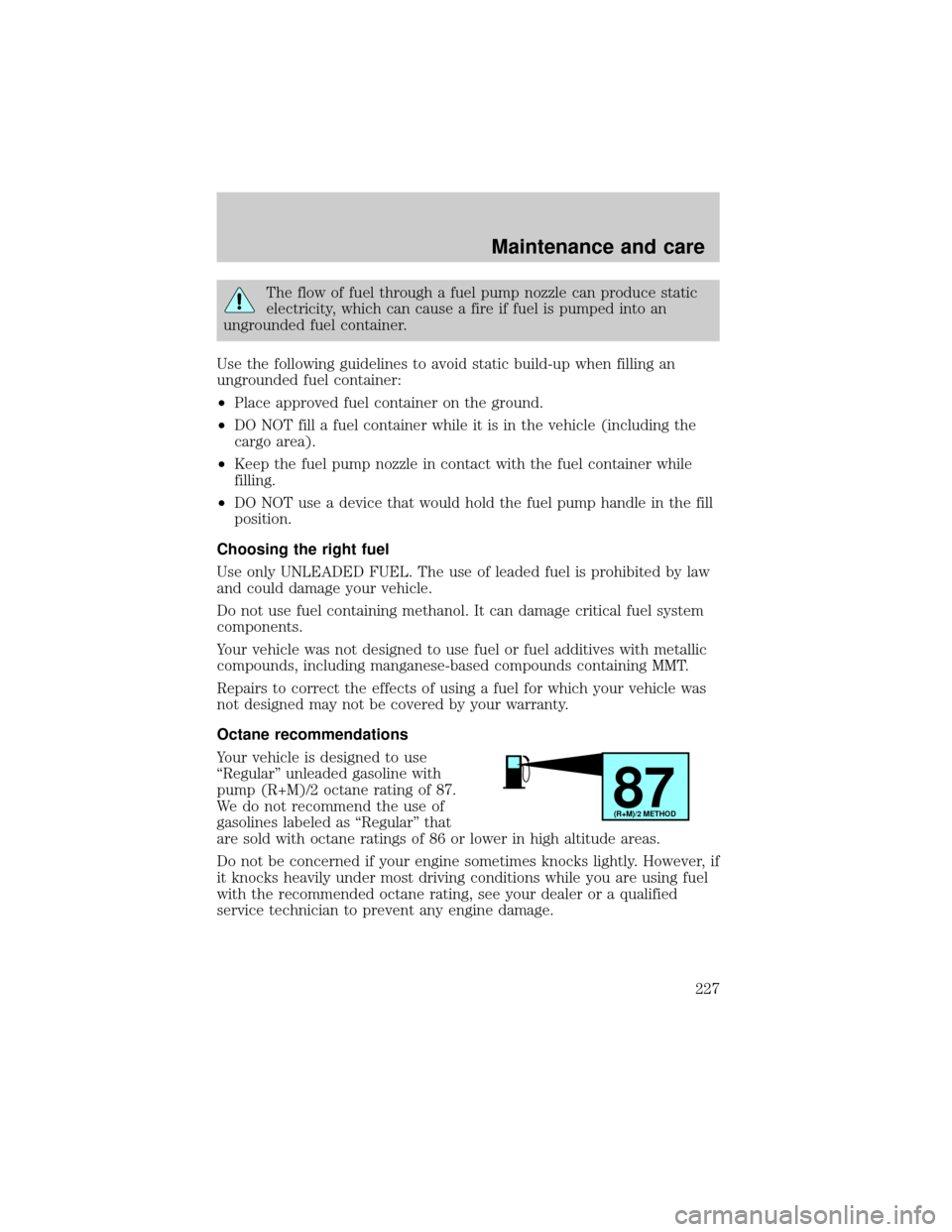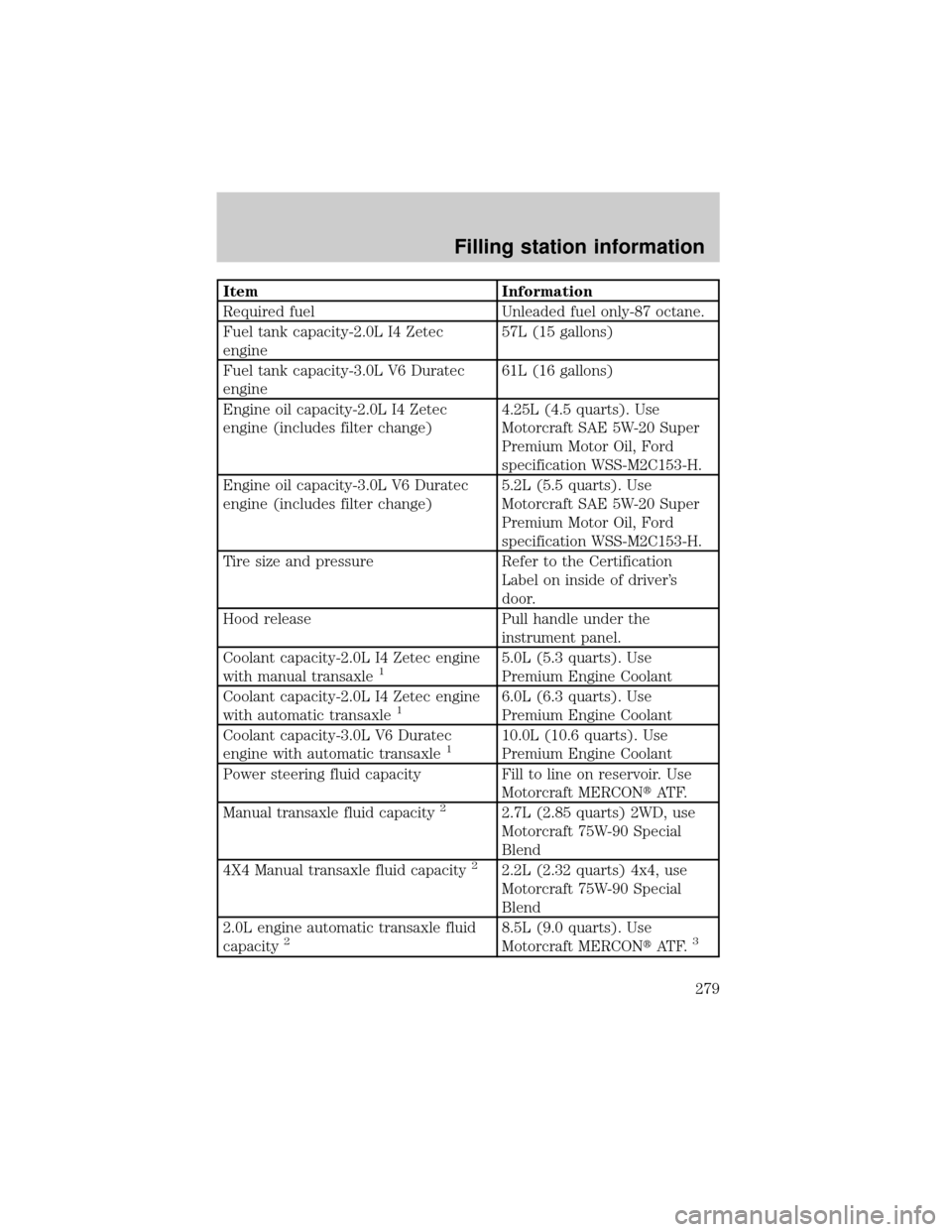2001 FORD ESCAPE octane
[x] Cancel search: octanePage 11 of 280

These temporary malfunctions can be corrected by filling the fuel tank
with high quality fuel of the recommended octane and/or properly
installing and securely tightening the fuel cap. After three driving cycles
without these or any other temporary malfunctions present, the
light should turn off. (A driving cycle consists of a cold engine startup
followed by mixed city/highway driving.) No additional vehicle service is
required.
If the
light remains on, have your vehicle serviced at the first
available opportunity.
Light is blinking:
Engine misfire is occurring which could damage your catalytic converter.
You should drive in a moderate fashion (avoid heavy acceleration and
deceleration) and have your vehicle serviced at the first available
opportunity.
Under engine misfire conditions, excessive exhaust temperatures
could damage the catalytic converter, the fuel system, interior
floor coverings or other vehicle components, possibly causing a fire.
Low fuel
Illuminates as an early reminder of a
low fuel condition indicated on the
fuel gauge (refer toFuel gaugein
this chapter for more information).
When refueling, after the light
comes on, the amount of fuel that is added will be less than the
advertised capacity since there is fuel still in the tank. The ignition must
be in the RUN position for this lamp to illuminate. The lamp will also
illuminate for several seconds after the ignition is turned to the RUN
position regardless of the fuel level to ensure your bulb is working.
Air bag readiness
Momentarily illuminates when the
ignition is turned to the RUN
position. If the light fails to
illuminate, continues to flash or
remains on, have the system
serviced immediately.
Instrumentation
11
Page 227 of 280

The flow of fuel through a fuel pump nozzle can produce static
electricity, which can cause a fire if fuel is pumped into an
ungrounded fuel container.
Use the following guidelines to avoid static build-up when filling an
ungrounded fuel container:
²Place approved fuel container on the ground.
²DO NOT fill a fuel container while it is in the vehicle (including the
cargo area).
²Keep the fuel pump nozzle in contact with the fuel container while
filling.
²DO NOT use a device that would hold the fuel pump handle in the fill
position.
Choosing the right fuel
Use only UNLEADED FUEL. The use of leaded fuel is prohibited by law
and could damage your vehicle.
Do not use fuel containing methanol. It can damage critical fuel system
components.
Your vehicle was not designed to use fuel or fuel additives with metallic
compounds, including manganese-based compounds containing MMT.
Repairs to correct the effects of using a fuel for which your vehicle was
not designed may not be covered by your warranty.
Octane recommendations
Your vehicle is designed to use
ªRegularº unleaded gasoline with
pump (R+M)/2 octane rating of 87.
We do not recommend the use of
gasolines labeled as ªRegularº that
are sold with octane ratings of 86 or lower in high altitude areas.
Do not be concerned if your engine sometimes knocks lightly. However, if
it knocks heavily under most driving conditions while you are using fuel
with the recommended octane rating, see your dealer or a qualified
service technician to prevent any engine damage.
87(R+M)/2 METHOD
Maintenance and care
227
Page 228 of 280

Fuel quality
If you are experiencing starting, rough idle or hesitation driveability
problems during a cold start, try a different brand of ªRegularº unleaded
gasoline. ªPremiumº unleaded gasoline is not recommended (particularly
in the United States) because it may cause these problems to become
more pronounced. If the problems persist, see your dealer or a qualified
service technician.
It should not be necessary to add any aftermarket products to your fuel
tank if you continue to use high quality fuel of the recommended octane
rating. Aftermarket products could cause damage to the fuel system.
Repairs to correct the effects of using an aftermarket product in your
fuel may not be covered by your warranty.
Many of the world's automakers
issued the World-wide Fuel Charter
that recommends gasoline
specifications to provide improved
performance and emission control
system protection for your vehicle.
Gasolines that meet the World-wide
Fuel Charter should be used when
available. Ask your fuel supplier
about gasolines that meet the
World-wide Fuel Charter. In Canada,
look for fuels that display theAuto Makers' Choiceylogo.
Cleaner air
Ford endorses the use of reformulated ªcleaner-burningº gasolines to
improve air quality.
Running out of fuel
Avoid running out of fuel because this situation may have an adverse
affect on powertrain components.
If you have run out of fuel:
²You may need to cycle the ignition from OFF to ON several times after
refueling, to allow the fuel system to pump the fuel from the tank to
the engine.
²The
indicator may come on. For more information on the ªCheck
Engineº indicator, refer to theInstrumentationchapter.
Maintenance and care
228
Page 231 of 280

²Allow no more than 2 automatic click-offs when filling.
²Always use fuel with the recommended octane rating.
²Use a known quality gasoline, preferably a national brand.
²Use the same side of the same pump and have the vehicle facing the
same direction each time you fill up.
²Have the vehicle loading and distribution the same every time.
Your results will be most accurate if your filling method is consistent.
Calculating fuel economy
1. Fill the fuel tank completely and record the initial odometer reading
(in kilometers or miles).
2. Each time you fill the tank, record the amount of fuel added (in liters
or gallons).
3. After at least three to five tank fill-ups, fill the fuel tank and record
the current odometer reading.
4. Subtract your initial odometer reading from the current odometer
reading.
5. Follow one of the simple calculations in order to determine fuel
economy:
Multiply liters used by 100, then divide by total kilometers
traveled.
Divide total miles traveled by total gallons used.
Keep a record for at least one month and record the type of driving (city
or highway). This will provide an accurate estimate of the vehicle's fuel
economy under current driving conditions. Additionally, keeping records
during summer and winter will show how temperature impacts fuel
economy. In general, lower temperatures give lower fuel economy.
Driving style Ð good driving and fuel economy habits
Give consideration to the lists that follow and you may be able to change
a number of variables and improve your fuel economy.
Habits
²Smooth, moderate operation can yield up to 10% savings in fuel.
²Steady speeds without stopping will usually give the best fuel
economy.
Maintenance and care
231
Page 252 of 280

suspected or repair required. Replace Power Take-off(PTO) lubricant
with specified synthetic lubricant anytime the unit is submerged in
water. Never engage the 4X4 feature while on dry pavement.
44X4 vehicles exposed for prolonged periods to temperatures less than
±40É C (-40É F) should change out the rear axle fluid to Motorcraft SAE
75W-140 Synthetic Rear Axle Lubricant, Ford part number
XY-75W140±QL meeting Ford specification WSL-M2C192±A.
ENGINE DATA
Engine 2.0L DOHC I4 Zetec
engine3.0L DOHC V6
Duratec engine
Cubic inches 121 181
Required fuel 87 octane 87 octane
Firing order 1-3-4-2 1-4-2-5-3-6
Spark plug gap 1.22-1.32 mm
(0.048-0.052 inch)1.32-1.42 mm
(0.052-00.056 inch)
Ignition system DIS Coil on plug
Compression ratio 9.6:1 10.0:1
VEHICLE DIMENSIONS
Dimensions 4 Door mm (in.)
(1) Vehicle height/ Maximum
height*1 755 (69.1)/1 774 (69.8)*
(2) Front track / rear 1 551 (61.1)/1 530 (60.2)
(3)Overall width (body) 1 780 (70.1)
(4) Wheelbase 2 620 (103.1)
(5)Overall length 4 393 (173.0)
Capacities and specifications
252
Page 272 of 280

lubrication
specifications ..................250, 252
refill capacities ........................247
service points ..................199±200
starting after a collision .........174
Engine block heater .................140
Engine oil ..................................201
checking and adding ..............201
dipstick ....................................201
filter, specifications ........204, 247
recommendations ...................204
refill capacities ........................247
specifications ..................250, 252
Exhaust fumes ..........................140
F
Fluid capacities .........................247
Foglamps .....................................82
Four-Wheel Drive vehicles
description ..............................151
driving off road .......................152
indicator light ...................14, 152
preparing to drive your
vehicle .....................................145
Fuel ............................................225
calculating fuel economy .......230
cap .....................................15, 229
capacity ...................................247
choosing the right fuel ...........227
comparisons with EPA fuel
economy estimates .................233
detergent in fuel .....................228
filling your vehicle with
fuel ...........................225, 229±230
filter, specifications ........230, 247
fuel pump shut-off switch .....174
gauge .........................................17
improving fuel economy ........230low fuel warning light ..............11
octane rating ...................227, 252
quality ......................................228
running out of fuel .................228
safety information relating to
automotive fuels .....................225
Fuses ..................................176±177
G
Garage door opener ....................78
Gas cap (see Fuel cap) ......15, 229
Gas mileage (see Fuel
economy) ...................................230
Gauges .........................................16
engine coolant temperature
gauge .........................................16
fuel gauge ..................................17
odometer ...................................18
speedometer .............................17
tachometer ................................17
GAWR (Gross Axle Weight
Rating) .......................................155
calculating ...............................157
definition .................................155
driving with a heavy load ......155
location ....................................155
GVWR (Gross Vehicle Weight
Rating) .......................................155
calculating .......................155, 157
definition .................................155
driving with a heavy load ......155
location ....................................155
H
Hazard flashers .........................174
Head restraints .........................100
Index
272
Page 274 of 280

Load limits .................................155
GAWR ......................................155
GVWR ......................................155
trailer towing ..........................155
Loading instructions .................156
Locks
childproof ..................................84
Lubricant specifications ...250, 252
Lumbar support, seats .............100
M
Manual transaxle
fluid, checking and adding ....216
Manual transmission
fluid capacities ........................247
lubricant specifications ..........252
Mirrors
cleaning ...................................246
fold away ...................................20
side view mirrors (power) .......19
Moon roof ....................................79
Motorcraft parts ................230, 247
O
Octane rating ............................227
Odometer .....................................18
Off-Road Driving .......................152
Oil (see Engine oil) ..................201
Overdrive ...................................146
P
Panic alarm feature, remote
entry system ................................90
Parking brake ............................143Parts (see Motorcraft parts) ....247
Power distribution box (see
Fuses) ........................................180
Power door locks ........................84
Power steering ..........................144
fluid, checking and adding ....213
fluid, refill capacity ................247
fluid, specifications .........250, 252
Preparing to drive your
vehicle ........................................145
R
Radio ............................................26
Rear window defroster ...............20
Relays ........................................176
Remote entry system ...........89±90
illuminated entry ......................92
locking/unlocking doors ...........90
panic alarm ...............................90
replacement/additional
transmitters ...............................91
replacing the batteries .............91
Roof rack ...................................162
S
Safety belts (see Safety
restraints) ....................15, 107±111
Safety defects, reporting ..........269
Safety restraints ................107±111
belt minder .............................113
cleaning the safety
belts .................................117, 246
extension assembly ................112
for adults .........................108±110
for children .............................127
lap belt ....................................112
Index
274
Page 279 of 280

Item Information
Required fuel Unleaded fuel only-87 octane.
Fuel tank capacity-2.0L I4 Zetec
engine57L (15 gallons)
Fuel tank capacity-3.0L V6 Duratec
engine61L (16 gallons)
Engine oil capacity-2.0L I4 Zetec
engine (includes filter change)4.25L (4.5 quarts). Use
Motorcraft SAE 5W-20 Super
Premium Motor Oil, Ford
specification WSS-M2C153-H.
Engine oil capacity-3.0L V6 Duratec
engine (includes filter change)5.2L (5.5 quarts). Use
Motorcraft SAE 5W-20 Super
Premium Motor Oil, Ford
specification WSS-M2C153-H.
Tire size and pressure Refer to the Certification
Label on inside of driver's
door.
Hood release Pull handle under the
instrument panel.
Coolant capacity-2.0L I4 Zetec engine
with manual transaxle
15.0L (5.3 quarts). Use
Premium Engine Coolant
Coolant capacity-2.0L I4 Zetec engine
with automatic transaxle
16.0L (6.3 quarts). Use
Premium Engine Coolant
Coolant capacity-3.0L V6 Duratec
engine with automatic transaxle
110.0L (10.6 quarts). Use
Premium Engine Coolant
Power steering fluid capacity Fill to line on reservoir. Use
Motorcraft MERCONtAT F.
Manual transaxle fluid capacity
22.7L (2.85 quarts) 2WD, use
Motorcraft 75W-90 Special
Blend
4X4 Manual transaxle fluid capacity
22.2L (2.32 quarts) 4x4, use
Motorcraft 75W-90 Special
Blend
2.0L engine automatic transaxle fluid
capacity
28.5L (9.0 quarts). Use
Motorcraft MERCONtAT F.3
Filling station information
279